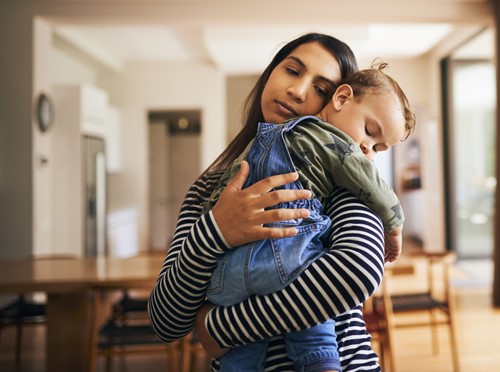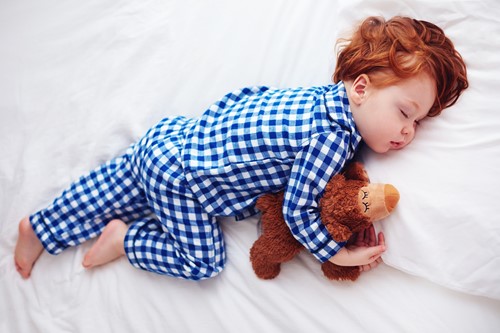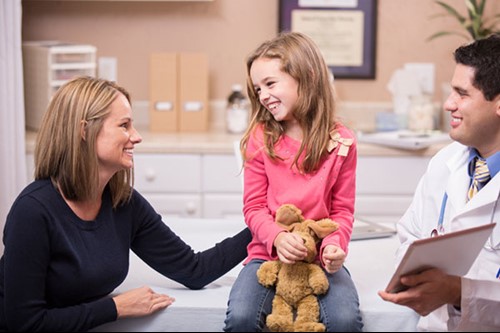If your child isn’t sleeping well, his health and well-being may suffer. Often, parents and others in the family are affected too.
Disordered sleep can cause a host of problems, ranging from fatigue and sleepiness during the day to hyperactivity, trouble in school, frequent ear infection or instances of strep throat and more.

Unfortunately, sleep problems aren’t easy to diagnose in children and teens. Often, youngsters aren’t aware when their sleep is disrupted. And children don’t always exhibit the same symptoms that adults typically suffer due to poor sleep. While an adult who isn’t sleeping well may be drowsy all day, a child may be hyperactive.
Furthermore, a child may sleep an adequate number of hours at night, but still not get good enough quality sleep. The child may awaken feeling even more tired in the morning and feel tired throughout the day.
If you suspect your child may have sleep problems, talk with your pediatrician and ask if a sleep study is in order.
The Pediatric Sleep Institute, a department of Texas Health Center for Diagnostics & Surgery, offers the expertise and the technology to detect and diagnose your child's sleep disorder. With the results from a sleep study, your physician can decide on the best treatment plan appropriate to your child’s age and needs.
Symptoms to watch out for
Many parents inquire about a sleep study when they notice their child or teen is not sleeping soundly. The child may have trouble falling asleep or staying asleep. While in bed, the child may snore, move around excessively or grind his teeth. The child’s limbs may twitch or jerk during sleep, or the child may complain of pain or discomfort in his legs at bedtime. In the morning, a child with a sleep problem may have difficulty waking up, even after an adequate number of hours of sleep.
New onset bedwetting – which occurs after the child has been potty-trained – may also indicate a potential sleep issue.
Frequent parasomnias – night terrors, sleep walking or sleep eating – can also signal a sleep problem.
Behavioral issues may also point to a need for a sleep evaluation. During the day, a child with poor sleep may experience daytime sleepiness, difficulty concentrating in school or remembering information, or behaviors that mirror attention deficit disorder (ADD) or attention deficit hyperactivity disorder (ADHD). Studies have shown that sleep disturbances can cause a wide range of behavioral issues. Even simple snoring is linked to decreases in a child's performance and attentiveness at school.
Frequent ear infections or instances of strep throat can also signal a sleep problem. A child with sleep disordered breathing may sleep with his or her head tilted back, in an unconscious effort to open up the airway. That position prevents mucus from draining properly in the ears, nose and throat, which can lead to infection.
If your child is experiencing any of these issues, seek the advice of a trusted physician. Ask if a sleep study -- an overnight test that can record a variety of body functions while a child sleep – to help pinpoint and diagnose the problem is needed.
What is a sleep study?
Doctors recommend a sleep study for kids who are suspected to have sleep problems such as obstructive sleep apnea, periodic limb movement disorder or restless leg syndrome, or narcolepsy, a chronic sleep disorder that causes overwhelming daytime drowsiness.
Sometimes your pediatrician may recommend a sleep evaluation to help determine is a sleep study is warranted. A sleep evaluation is a consultation with a board-certified pediatric sleep specialist to discuss sleep questions and symptoms your child may be exhibiting. In many cases, the sleep specialist will recommend a pediatric polysomnogram, or sleep study. The pediatric sleep study may be conducted with children as young as six months, up to age 18. Most insurance plans do cover sleep studies.

For this test, the child will spend the night in a comfortable sleeping room in the Pediatric Sleep Institute’s lab along, with a parent or guardian. The room is furnished with a twin bed, TV and DVD player and bathroom. A pullout sofa is provided for the parent or guardian. Your child may bring items from home to feel comfortable during the sleep study, such as pajamas, a favorite pillow, blanket, or stuffed animal, books, snacks or other items that are part of your child's usual bedtime routine.
The child should get a normal night's sleep the night before the sleep study. Take any medicines as usual, and avoid anything with caffeine, including coffee, tea, chocolate or soda. The child should not nap during the day of the sleep study.
Upon arrival, a technician will prepare the child for the evaluation by attaching sensors on your child in different areas, such as on the head, chin, and legs, and around the eyes. An elastic belt may be secured around your child's chest and stomach to measure breathing. The sensors connect to a computer to provide information during sleep. The process is painless and non-invasive.
The sleep study provides a lot of useful information that cannot be pinpointed through observation or a physical exam. The study will monitor your child’s sleeping cycles, breathing and more with a wide range of different readings taken over the course of the night.
These readings will include:
-
An electroencephalogram (EEG) to detect electrical activity in the brain using small, metal discs (electrodes) attached to the child’s scalp to monitor the child’s sleeping and wa
king patterns. Brain cells communicate via electrical impulses and are active all the time, even when the child is asleep.
-
An electrocardiogram (EKG) to record activity in the child’s heart.
-
Leads attached to the chin to detect bruxism – grinding of the teeth.
-
Sensors to monitor leg movements and other body movements.
-
Straps to record the rise and fall of the child’s chest and abdomen, indicating the child’s breathing patterns while asleep.
-
A pulse oximeter on the finger or the toe to monitor blood oxygen levels as well as CO2 levels.
-
A detector to record eye movements.
-
A microphone and camera in the room to record the child’s sleep.
 The next morning, the technician will wake the child and remove the sensors and apparatus. The test will be completed in time for the child to go to school.
The next morning, the technician will wake the child and remove the sensors and apparatus. The test will be completed in time for the child to go to school.
(If narcolepsy is suspected, the study may continue into the following day, with sleep latency tests taken when the child naps.)
Doctors get a lot of information from a sleep study, so it may take a week or two before the results are available to share in a follow-up visit to discuss the results.
The data from the sleep study is provided to a board-certified pediatric sleep physician, who studies the results in order to accurately diagnose the type of sleep disorder and to prescribe an appropriate treatment plan.
A few common sleep problems that a sleep study may diagnose:
Pediatric sleep apnea: With this condition, the patient’s airway passages are partially obstructed, resulting in pauses in breathing during the night. These brief, frequent arousals prevent the child from getting the kind of deep, restorative sleep needed. Usually, the child is unaware that he is waking up. Treatment may include surgery to remove enlarged tonsils and/or adenoids; continuous positive airway pressure (CPAP) therapy provided through a mask worn during sleep; or an oral appliance to aid the child’s breathing during sleep.
Pediatric RLS or PLMS: Children with Restless Legs Syndrome (RLS) or Periodic Leg Movement Syndrome (PLMS) experience sudden jerking or bending of the arms and legs during sleep. These symptoms can range from slight twitching of the ankles and toes to leg kicks and flailing of arms and legs. These periodic movements interrupt the child’s sleep and affect the quality of the sleep. When a sleep study indicates RLS, a blood test for iron deficiency is ordered. If a deficiency is detected, iron supplements may be prescribed.
Pediatric narcolepsy: A chronic neurological condition caused by the brain's inability to regulate the sleep-wake cycle normally. Children with narcolepsy have uncontrollable urges to sleep at inappropriate times during the day. Treatment typically includes medications, lifestyle behavior modifications (eating, drinking and sleeping tips) and educating teachers, coaches and others about how this disorder may affect the child’s functioning.
Note that not all sleep problems require a sleep study for treatment and not all treatments require medication. In some cases, a sleep study may serve to eliminate sleep problems as the cause of the symptoms or concerns in question.
But when the sleep study does reveal problems with the child’s sleep, your physician can recommend an effective treatment plan. Your child, and the rest of the family, can once again enjoy a good night’s sleep.

